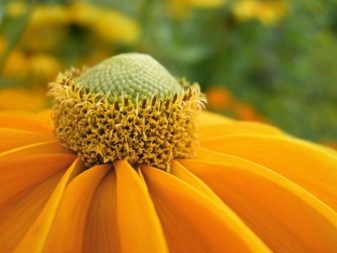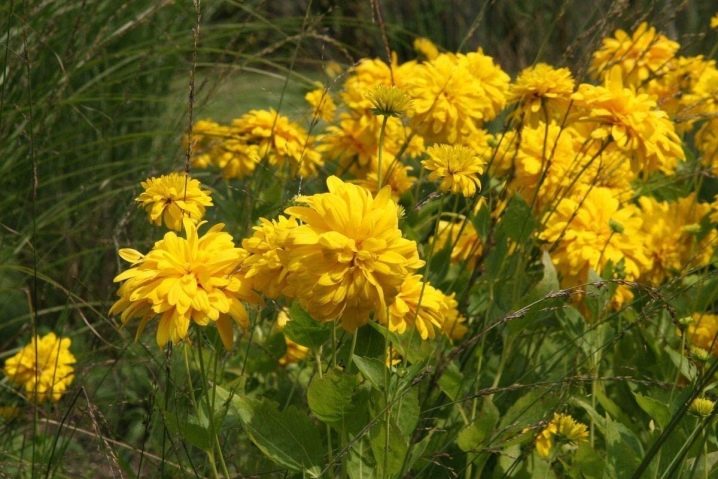All about dissected rudbeckia

Everything about dissected rudbeckia is extensive information about the plant, which belongs to the Aster family (more than 40 species). Knowledge about annual, biennial or perennial flowers, common on the European, North American and African continents, in the wild, prairies, will help in the cultivation of dissected rudbeckia. Let's find out everything about plants cultivated as an unpretentious ornamental plantation or spread through strong rhizomes and run wild on the outskirts of villages, extensive private land holdings.

Description
K. Linnaeus, who honored Professor Rudbeck in the process of describing the species, did not think that the flowers of a plant with a black core would become widespread and beloved in different countries of the world, numerous hybrids would appear, and without rudbeckia it would be simply impossible to imagine a beautiful flower garden. The convex inner part of the rudbeckia and its picturesque inflorescences are not the only reasons for its popularity.
High growth, long flowering of this plant, mainly perennial varieties resistant to cold and frosty winters of a temperate climate, distinguish it from many similar ornamental varieties.
Rudbeckia dissected - the source material for the famous "Golden ball" variety. The hairy and shiny rudbeckia are also grounds for hybrid varieties, two-colored and embracing, like the sun-glazed, are rarely found in cultivated breeding. They can be found among the devoted admirers of this genus or the Asteraceae family.

Annual or perennial rudbeckia in the wild resembles a shrub due to its tall growth and strong stems. In decorative floriculture, it is described as a plant:
-
reaching a height of half a meter to 3 m;
-
with simple or fancifully branched stems, smooth or with a hard down;
-
with leaves of variable size (5-25 cm);
-
with vegetative mass whole, pinnately separate, oval or egg-shaped;
-
having inflorescences-baskets, large in size, with a beautiful combined or monochrome color;
-
with a convex-cylindrical receptacle and sharp bracts.
In the color scheme, one can find unmatched shades and color combinations, mostly bright (yellow, orange in the marginal flowers and black, brown, with a purple tint in the tubular, bisexual median flowers). The seed-fruit, often with a small crown, oblong, has no other purpose. Flowering lasts about two months, but may last longer depending on the variety and climate of the region in which the plant is planted.


Types and varieties
All hybrids and varieties - the result of the painstaking work of nature and breeders - is difficult to list. Some of them are found in natural conditions, but there are also cultural, widespread and rare, which can be found only in flower beds or front gardens. The plant spreads by rhizome over large areas of the land plot, therefore it is sometimes limited immediately upon planting.
Those who cannot devote much time to their plantings are satisfied with cold resistance, unpretentiousness and long-term shoots. They are proud of flowers that bloom in the midst of the warm season and appear at an enviable frequency before the onset of cold. There are many varieties of rudbeckia seeds available at the flower shop.
Here are the most frequent inhabitants of flower beds.
-
"Golden Spring", or Goldquelle ("Goldquelle") - a tall, branched plant, perennial with double (or semi-double) flowers, winter-hardy and with long flowering.

- "Golden Ball" or "Goldball" - a popular among Russians herbaceous perennial, in good conditions reaching a height of 2 m, with multi-petal baskets up to 10 cm in diameter, yellow-green, blooming until frost.

- "Golden Fountain" or "Golden Fontaine" erroneously ranked in some sources as analogs of the "Golden Source". The variety has some external similarity, but reaches no more than 1 m in height.

- Rudbeckia brilliant (radiant), with inflorescences of a combined color (tubular dark purple and orange reed petals) - also a perennial, low (up to 70 cm).

- "Golden Storm" and "Golden Star" - medium-high, with large inflorescences. They are often called garden daisies by lovers.


There are other varieties - "Marmalade", "Glossy", "Yantar", "Green Magician", which are less common, require more attention or are used only in group beds. For example, the "Green Wizard" requires an open and lit space, regular pruning of dried flowers, but looks like a cone with small green petals.
"Golden ball" is the most common variety of dissected rudbeckia, it is used in landscape design, ennoble hedges and bare walls of houses, tied to trellises and pegs to arrange the zoning of a small area.

Planting and leaving
Dense, clayey and waterlogged soils are not suitable for this plant. Rudbeckia prefers illuminated areas, but it also grows in partial shade, where the light is diffused.
In the spring, she needs a little complex fertilizers; in a drought, periodic watering is required. At the same time, removing dried inflorescences, you can prevent the formation of a fruit and extend the decorative period.

Reproduction
Seeds are the most demanded breeding species for rudbeckia. On sale there are both simple and elite varieties like "Mocha", "Trehlopastnaya", "Cappuccino" and "Purple". But some of them are hybrid annuals, and perennials are planted in open ground or for seedlings. The second method allows you to get flowering immediately, the first will give results only the next year. Seed material is planted in early spring or early April, depending on the method chosen.
The spread of the plant by rhizomes requires its limitation, but you can periodically relocate the plant to another place for rejuvenation and at the same time divide the rhizomes to obtain new plantations.
In nurseries, you can buy rudbeckia in pots - for year-round transplantation or decorative needs.

Diseases and pests
Susceptibility to diseases and pests appears in extreme conditions that weaken natural immunity. In drought, rudbeckia can be invaded by aphids or spider mites. The appearance of powdery mildew - a fungal disease - is inevitable with a permanent excess of moisture. Chemicals can be used against pests, and preventive treatment with fungicides can be carried out against the fungus and waterlogging can be prevented. If the fungus appears, there is only one way out - the destruction of the affected plant.
Rudbeckia dissected is a flower garden decoration. The plant is very picturesque; many growers use it to decorate flower beds.









The comment was sent successfully.